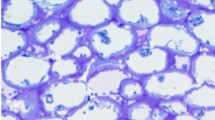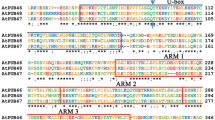Abstract
The cut hypocotyl of Ricinus communis L. seedlings exudes phloem sap which contains a characteristic set of proteins (Sakuth et al. 1993, Planta 191, 207–213). These sieve-tube exudate proteins were probed with antibodies to highly conserved proteins, namely ribulose 1,5-bisphosphate carboxylase-oxygenase (Rubisco), Rubisco subunit-binding protein, heat-shock protein (HSP 70), chaperonin GroEL and ubiquitin. Homologous proteins in the sieve-tube exudate were identified with antisera to HSP 70, Rubisco-subunit-binding protein and ubiquitin. Ribulose-1,5-bisphosphate carboxylase-oxygenase, which was present in the tissue, was not detected. Of all the cross-reactive proteins detected, ubiquitin was special because the ubiquitin-to-protein ratio in the sieve-tube exudate was higher than in both the surrounding hypocotyl and in the cotyledonary tissues. Therefore, ubiquitin features properties which favour its transfer into the sieve tubes and which might rely on efficient transport through plasmodesmata. It is assumed that chaperones and ubiquitin are needed for the maintenance of sieve-tube function, e.g. to ensure correct folding of proteins. Their possible involvement in protein translocation through plasmodesmata from companion cells to sieve tubes is discussed.
Similar content being viewed by others
Abbreviations
- HSP:
-
heat-shock protein
- Rubisco:
-
ribulose1,5-bisphosphate carboxylase-oxygenase
- RBP:
-
Rubisco-subunit-binding protein
- STEP:
-
sieve-tube exudate protein
References
Ang, D., Liberek, K., Skowyra, D., Zylicz, M., Georgopoulos, C. (1991) Biological role and regulation of the universally conserved heat shock proteins. J. Biol. Chem. 266, 24233–24236
Bachmair, A., Becker, F., Masterson, R.V., Schell, J. (1990) Perturbation of the ubiquitin system causes leaf curling, vascular tissue alterations and necrotic lesions in a higher plant. EMBO J. 9, 4543–4549
Bostwick, D.E., Dannenhoffer, J.M., Skaggs, M.I., Lister, R.M., Larkins, B.A., Thompson, G.A. (1992) Pumpkin phloem lectin genes are specifically expressed in companion cells. Plant Cell 4, 1539–1548
Citovsky, V. (1993) Probing plasmodesmal transport with plant viruses. Plant Physiol. 102, 1071–1076
Cronshaw, J. (1981) Phloem structure and function. Annu. Rev. Plant Physiol. 32, 465–484
Ellis, R.J. (1990) Molecular chaperones: The plant connection. Science 250, 954–959
Evert, R.F. (1990) Dicotyledons. In: Sieve elements, pp. 103–137, Behnke, H.-D., Sjolund, R.D., eds. Springer, Berlin Heidelberg New York
Finley, D., Bartel, B., Varshavsky, A. (1989) The tails of ubiquitin precursors are ribosomal proteins whose fusion to ubiquitin facilitates ribosome biogenesis. Nature 338, 394–401
Fisher, D.B., Wu, Y., Ku, M.S.B. (1992) Turnover of soluble proteins in the wheat sieve tube. Plant Physiol. 100, 1433–1441
Fujiwara, T., Giesman-Cookmeyer, D., Ding, B., Lommel, S.A., Lucas, W.J. (1993) Cell-to-cell trafficking of macromolecules through plasmodesmata potentiated by the red clover necrotic mosaic virus movement protein. Plant Cell 5, 1783–1794
Grimm, R., Speth, V., Gatenby, A.A., Schäfer, E. (1991) GroEL-related molecular chaperones are present in the cytosol of oat cells. FEBS Lett. 286, 155–158
Heinemeyer, W., Kleinschmidt, J.A., Saidowsky, J., Escher, C., Wolf, D.H. (1991) Proteinase yscE, the yeast proteasome/multicatalytic-multifunctional proteinase: mutants unravel its function in stress induced proteolysis and uncover its necessity for cell survival. EMBO J. 10, 555–562
Hemmingsen, S.M., Woolford, C., van der Vies, S.M., Tilly, K., Dennis, D.T., Georgopoulos, C.P., Hendrix, R.W., Ellis, R.J. (1988) Homologous plant and bacterial proteins chaperone oligomeric protein assembly. Nature 333, 330–334
Jentsch, S., Seufert, W., Sommer, T., Reins, H-A. (1990) Ubiquitinconjugating enzyems: novel regulators of eukaryotic cells. Trends Biochem. Sci. 15, 195–198
Kallarackal, J., Orlich, G., Schobert, C., Komor, E. (1989) Sucrose transport into the phloem of Ricinus seedlings as measured by sieve tube sap analysis. Planta 177, 327–335
Kempers, R., Prior, D.M.M., Van Bel, A.J.E., Oparka, K.J. (1993) Plasmodesmata between sieve elements and companion cells of extrafascicular phloem of Cucurbita maxima permit passage of 3 kDa fluorescent probes. Plant J. 4, 567–575
Lucas, W.J., Ding, B., van der School, C. (1993) Plasmodesmata and the supracellular nature of plants. New Phytol. 125, 435–476
Nakamura, S., Hayashi, H., Mori, S., Chino, M. (1993) Protein phosphorylation in the sieve tubes of rice plants. Plant Cell Physiol. 34, 927–933
Pfanner, N., Neupert, W. (1990) The mitochondrial protein import apparatus. Annu. Rev. Biochem. 59, 331–353
Raven, J.A. (1991) Long-term functioning of enucleate sieve elements: possible mechanisms of damage avoidance and damage repair. Plant Cell Environ. 14, 139–146
Sakuth, T., Schobert, C., Pecsvaradi, A., Eichholz, A., Komor, E., Orlich, G. (1993) Specific proteins in the sieve tube exudate of Ricinus communis L. seedlings: Separation, characterization and in vivo labelling. Planta 191, 207–213
Schägger, H., von Jagow, G. (1987) Tricine sodium dodecyl sulfate polyacrylamide gel electrophoresis for the separation of proteins in the range from 1 to 100 kDa. Anal. Biochem. 166, 368–377
Schliephacke, M., Kremp, A., Schmid, H.-P., Köhler, K., Kuli, U. (1991) Prosomes (proteasomes) of higher plants. Eur. J. Cell Biol. 55, 114–121
Schobert, C., Komor, E. (1987) Amino acid uptake by Ricinus communis roots: characterization and physiological significance. Plant Cell Environ. 10, 493–500
Seufert, W., Jentsch, S. (1990) Ubiquitin-conjugating enzymes UBC4 and UBC5 mediate selective degradation of short-lived and abnormal proteins. EMBO J. 9, 543–550
Seufert, W., Jentsch, S. (1992) in vivo function of the proteasome in the ubiquitin pathway. EMBO J. 11, 3077–3080
Simeon, A., van der Klei, I.J., Veenhuis, M., Wolf, D.H. (1992) Ubiquitin, a central component of selective cytoplasmic proteolysis, is linked to proteins residing at the locus of non-selective proteolysis, the vacuole. FEBS Lett. 301, 231–235
Smith, L.M., Sabnis, D.D., Johnson, R.P.C. (1987) Immunocytochemical localisation of phloem lectin from Cucurbita maxima using peroxidase and colloidal gold labels. Planta 170, 461–470
Vierling, E. (1991) The roles of heat shock proteins in plants. Annu. Rev. Plant Physiol. Plant Mol. Biol. 42, 579–620
Vierstra, R.D. (1993) Protein degradation in plants. Annu. Rev. Plant Physiol. Plant Mol. Biol. 44, 385–410
Author information
Authors and Affiliations
Corresponding author
Additional information
This research was supported by a TEMPUS grant European Community, Brüssel to E.K., which enabled the stay of A.P. The authors thank Dr. A. Bachmair (Institut für Botanik, Universität Wien, Austria), Prof. D. Wolf and Dr. A. Finger (Institut für Biochemie, Universität Stuttgart, Germany), Dr. S. Jentsch (Friedrich-Miescher Laboratorium, Max-Planck Institut Tübingen, Germany), Prof. U. Kull (Biologisches Institut, Universität Stuttgart, Germany), and Dr. T. Gatenby (Dupont, Wilmington, Del., USA) for generous supply of antisera used in this study. Improvement of English style was due to D. Schobert-Wiese.
Rights and permissions
About this article
Cite this article
Schobert, C., Großmann, P., Gottschalk, M. et al. Sieve-tube exudate from Ricinus communis L. seedlings contains ubiquitin and chaperones. Planta 196, 205–210 (1995). https://doi.org/10.1007/BF00201375
Received:
Accepted:
Issue Date:
DOI: https://doi.org/10.1007/BF00201375




